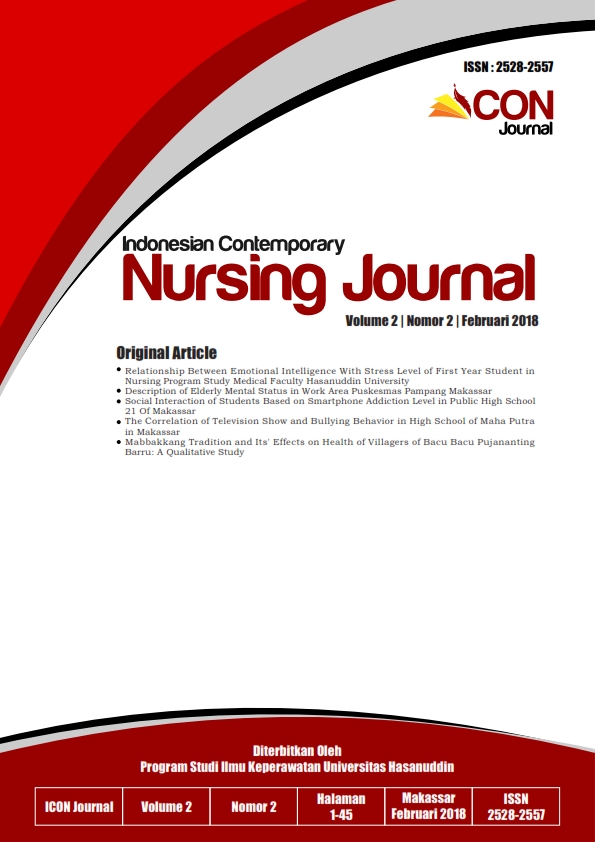The Correlation of Television Show and Bullying Behavior in High School of Mahaputra in Makassar
Abstract
Introduction: Bullying is an experience that occurs when the helplessness persecuted by the others behaviour and afraid of the repected bad behaviour and ill do it is repeated. One of causes bullying behavior is a television show, this can occur because television show that is presented is very diverse, so that school children is free to watch their favorite television show. This study aimed to determine the relationship between television show with bullying behavior in student of class XI and XII in SMA Maha Putra Makassar. Method: This study using cross sectional method. The total study populations 130 and samples are 98 respondents with purposive sampling technique. Data analyzed were using the Chi-Square. Result: In this study showed that there is no relationship between television show with bullying behavior in student of class XI and XII in Maha Putra Senior High School Makassar. Conclusions: Level bullying dominant is low level with the bullying often is verbal bullying, and program often that watched is soap opera. Therefore, they are expected to do more introduce of bullying to students.References
Adawiyah, S. E. (2014). Sinetron dalam sudut pandang komunikasi islam. Jakarta: Universitas Muhammadiyah.
Astuti, E. S., & Resminingsih. (2010). Bahan Dasar untuk PelayananKonseling pada Satuan Pendidikan Menengah Jakarta: Gradindo.
Dewi, C. K. (2015). Pengaruh konformitas teman sebaya terhadap perilaku bullying pada siswa SMA Negeri 1 Depok Yogyakarta. Jurnal Bimbingan dan Konseling, 1-12.
Fitrianingsih, A. (2015, Juni 17). Perbedaan cara berpikir anak IPA dan IPS. Retrieved November 28, 2016, from Kompasiana: http://www.kompasiana.com/am alia.fitrianingsih/perbedaan-cara- berpikir-anak-ipa-dan- ips_54f91a68a33311b6078b4624
Gurian, M. (2006). The wonder of boys. Jakarta: PT Serambi Ilmu Semesta.
Hamdi, I. (2016, April 15). KPAI: Kekerasan terhadap Anak Naik 15 Persen. Retrieved Agustus 23, 2016, from Tempo.Co: https://m.tempo.co/read/news/2016/04/15/063762948/kpai-kekerasan-terhadap-anak-naik-15-persen
Hazliansyah. (2015, Desember 30). KPAI : Kasus Bullying di Sekolah Meningkat Selama 2015. Retrieved Agustus 23, 2016, from Republika.co.id: http://m.republika.co.id/berita/n asional/umum/15/12/30/o067zt280-kpai-kasus-bullying-di-sekolah-meningkat-selama-2015
Karina, Hastuti, D., & Alfiasan. (2013). Perilaku bullying dan karakter remaja serta kaitannya dengan karakteristik keluarga dan peer group. Jurnal Ilmu Keluarga & Konseling, 20-29.
Kartono. (2014). Patologi sosial 2 kenakalan remaja.Jakarta: Rajawali Press
Komisi Perlindungan Anak Indonesia (KPAI). (2014, Oktober 16). KPAI : Kasus bullying dan pendidikan karakter. Retrieved September 25, 2016, from Komisi Perlindungan Anak Indonesia: www.kpai.go.id/berita/kpai- kasus-bullying-dan-pendidikan- karakter
KPAI. (2016, Januari 20). KPAI : 'Quo vadis' perlindungan anak di sekolah : Antara norma dan realita. Retrieved September 25, 2016, from Komisi Perlindungan Anak Indonesia: www.kpai.go.id/berita/kpai-quo- vadis-perlindungan-anak-di- sekolah-antara-norma-dan- realita/
KPI. (2015). Hasil survei indeks kualitas program siaran televisi.
Malikhah. (2013). Korelasi pengaruh tayangan televisi terhadap perkembangan perilaku negatif pada anak usia dini. [Skripsi Dipublikasikan]. Semarang: Universitas Negeri Semarang.
Morgan, N. (2014). Panduan mengatasi stress bagi remaja. Tangerang: Gemilang.
Nugraha, A. K. (2016, Mei 26). Berikut data kekerasan seksual pada anak 2015-2016. Retrieved Agustus 24, 2016, from Rakyatku News: http://news.rakyatku.com/read/6525/2016/05/26/berikut-data-kekerasan-seksual-pada-anak-2015-2016
Nurhayanti, R., Novotasari, D., & Natalia. (2013). Tipe pola asuh orang tua yang berhubungan dengan perilaku bullying di SMA Kabupaten Semarang. Jurnal Keperawatan Jiwa, 49-59
Pambudhi, Y. A., & Suroso, T. M. (2015). Efektivitas Group Cognitive Behavior Therapy (GCBT) dalam menurunkan kecemasan menghadapi perilaku bullying ditinjau dari harga diri pada korban bullying. Jurnal Ilmiah Psikologi Terapan, 18-31.
Priyantna, A. (2010). Lets end bullying, memahami, mencegah & mengatasi bullying. Jakarta: PT Elex Media Komputindo.
Rini, C. L. (2014, Oktober 23). Indonesia masuk kategori darurat bullying' di sekolah. Retrieved September 1, 2016, from News Republika.co.id: http://m.republika.co.id/berita/n asional/umum/14/10/23/ndvn63-indonesia-masuk-kategori- darurat-bullying-di-sekolah
Saifullah, F. (2014). Hubungan antara konsep diri dengan perilaku bullying pada siswa siswi SMP. eJournal Psikologi, 200-214.
Sherwood, L. (2013). Fisiologi manusia dari sel ke sistem, edisi 6.Jakarta: EGC.
Sonneborn, L. (2013). How to beat verbal bullying. New York: The Rosen Publishing Group.
Supartini, Y. (2004). Buku ajar konsep dasar keperawatan anak. Jakarta: EGC.
Takariani, C. S. (2013). Pengaruh sinetron remaja di televisi swasta terhadap sikap mengenai gaya hidup hedonis. Jurnal Penelitian Komunikasi, 39-54.
Usman, I. (2013). Kepribadian, Komunikasi, Kelompok Teman Sebaya, Iklim Sekolah dan Perilaku Bullying. Humanitas, Vol. X No.1, 49-60.
Verlinden, M., & all, e. (2014). Television viewing trought age 2-5 years and bullying involvement in early elementary school. BMC Public Health, 1-13.
Downloads
Published
Issue
Section
License
Authors who publish with this journal agree to the following terms:Authors retain copyright and grant the journal right of first publication with the work simultaneously licensed under a Creative Commons Attribution License that allows others to share the work with an acknowledgement of the work's authorship and initial publication in this journal.
Authors are able to enter into separate, additional contractual arrangements for the non-exclusive distribution of the journal's published version of the work (e.g., post it to an institutional repository or publish it in a book), with an acknowledgement of its initial publication in this journal.
Authors are permitted and encouraged to post their work online (e.g., in institutional repositories or on their website) prior to and during the submission process, as it can lead to productive exchanges, as well as earlier and greater citation of published work (See The Effect of Open Access).


